« Watching "The Frogmen" (1951) | Main | Hoi An Hoard -- an amazing tale of a buck well spent »
July 29, 2010
Back to Roatan
When you're a diver, you're always torn between wanting to explore new places you've never seen, and going back to places you know and love. And sometimes you simply end up wherever you get a good deal on airfare. This time we booked on very short notice, three days or so, using our frequent flyer miles. And went back to CocoView on Roatan, a place that I really love.
Booking with those frequent flyer miles was a pain. Not only are the airlines doing their darndest to make it as inconvenient as possible so as to discourage you from actually spending your miles (how'd you like to leave for a destination and get there two days later?), but seats and flights suddenly become unavailable if you so much as wait ten minutes or so. And when you finally find something that works, you learn that the airline is now charging a US$75 per person just for you booking the ticket, and then they add more fees and taxes. And should you fall a bit short with miles and need to buy a few more, those cost very, very dearly. Not a pleasant experience at all, and even less so when you find that on flights where they only showed one last middle seat available, half the plane is empty.
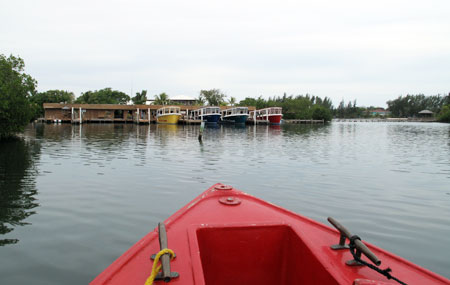
At Roatan we found Liz, the formerly ever-present manager, gone. Wonder what happened. A lot of new faces, too, though the dive staff seemed unchanged. Doc Radawski was still there and told me what happened during the earthquake that struck Roatan in May of 2009. Apparently, the fault that caused that 7.2 earthquake is on the same fault line as the one that ruined Port-au-Prince in Haiti. The epicenter of the Roatan quake was awfully close to the island, and Doc said had the quake lasted just 20 or 25 seconds longer, everything would have been leveled. As is, there was only fairly minor damage. Some piles under the cabanas broke through the floor, and some had to be replaced. Some pipes broke and power was lost. All in all, they got off easy.
Though we were exhausted from the red-eye flight from California, we hit the water within an hour upon our arrival, and it turned out to be a wonderful dive. The water was a balmy 84 degrees, visibility around the wreck of the Prince Albert was terrific, and though we had set out to examine CocoView Wall, we ended up at what’s left of a sunken DC3 near the shipwreck for most of the dive. The earthquake really pummeled the Prince Albert, with big cracks in its sides, as if plates had been torqued off. Things also look muddier and less colorful than I remember, but life is coming back. Same on the coral heads on CoCo View’s “front yard,†some of which were broken off or toppled over. A good deal of mud on everything, but you can see new growth coral, and there are a lot of fish.
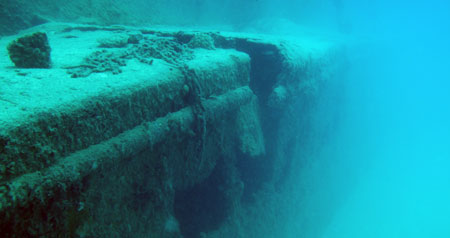
Anyone dreaming of vacations on tropical islands probably has visions of staying in one of those bungalows right on, or even over, the water. It became real for us as for the first three days we get to stay in one of the tropical bungalows. Each has two very large guest rooms and is just charming. I wish we could have stayed in one for the entire trip!
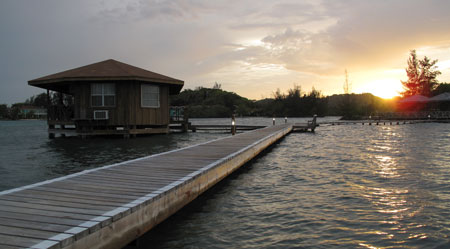
I was instantly reminded of something I didn't like so much about Roatan: biting insects. Unlike on Cozumel where it's obvious what bites you, on Roatan you have both the dreaded "no-see-ums" and almost equally undetectable flying things, and they both bite often and with very noticeable and very itchy results, almost no matter how careful you are. Bug spray and long pants and sleeves hardly seem to help at all. This is one little, but rather important, thing where liveaboards have it all over land-based locations.
Interestingly, the local time in Roatan is only one hour ahead of California in the summer. They don't use daylight savings time, and so it's dark at 7pm instead of 9:30, and in the morning it is light at 5am.
 The first full day of diving (4 dives) showed remarkably little damage from the 2009 earthquake. I had halfway expected much of those wonderful hanging and overhanging wall formations to be destroyed, but they were all still there. There also wasn't a lot of damage to fans and sponges; apparently they can handle an earthquake better than a hurricane. Everything looked pretty much as before, which means lots of colors, lots of diversity, and all those vertical walls.
The first full day of diving (4 dives) showed remarkably little damage from the 2009 earthquake. I had halfway expected much of those wonderful hanging and overhanging wall formations to be destroyed, but they were all still there. There also wasn't a lot of damage to fans and sponges; apparently they can handle an earthquake better than a hurricane. Everything looked pretty much as before, which means lots of colors, lots of diversity, and all those vertical walls.
The water was surprisingly rough, with even CoCo View's large dive boats in for a ride. Between the two morning dives we actually had to find sanctuary behind Fantasy Island.
Electricity! Whereas we had to make do with two electrical outlets at the Wyndham in Cozumel, and the Occidental Grand there wasn't much better, CoCo View knows that divers need a lot of outlets! Our Bungalow D had no fewer than 12 electrical plugs, enough for all of our camera and computer gear. And the standard rooms are not far behind. Now if they'd only supply WiFi to the rooms.
The bugs are a total nuisance. You don't remember this much afterwards, but they can really make you feel uncomfortable and paranoid to even go and enjoy the wonderful outdoors. Even with great precautions, we ended up itching like crazy after just a day, to the extent where it affected our mood and comfort. This alone can tip the scale in favor or against a location. Fortunately, at least, no flies here to further annoy you.
When you check the weather report for Roatan, you almost always see thunderclouds. That doesn't necessarily mean bad weather. It just means you never really know what to expect. Our first day was mostly nice and sunny. The second morning it was overcast, and the night before it looked like rain, which never came. The rest of this July trip alternated between overcast and bright sunshine, and occasional rain, especially at night. The seas alternated between quite rough and almost glass-smooth.
Dive masters are very important. Almost all dive masters are good at what they are doing and genuinely try to be helpful, look out after everyone, and make sure every diver has a good dive experience. However, styles differ, and there will always be dive masters that you particularly like. And feeling confident and comfortable with a dive master down there is important. When we made our reservations, we had asked to be assigned to one dive master who worked really well for us. There was no response to that, and when we got there no one knew of our request. We did get on his boat after a discussion with the manager of dive operations, but only for a day and a half. After that we were told we'd been reassigned to another boat and dive master because a large group was going to come in. That can happen, of course, but I did not like it and felt the resort handled this poorly. This is the kind of stuff that guests remember—requests handled with care, or simply ignored and brushed aside. And as it turned out, the boat we wanted to be on was never more than half-full and there'd been plenty of space for us.
As it turned out, on Saturday morning there was a major rain storm, a typical tropical pounding. I was certain the dive boats would not go out, but, surprise, they did and left right on time. And unlike on Cozumel where dive boats would only go to really close sites in inclement weather, Dive master Eddie (who captained this time) and relief DM Marcos took us to a couple of fantastic sites quite a ways away (Connie's Delight and Sponge Garden). Visibility was fantastic and we probably saw 150 feet. When the viz is good, Connie's Delight easily rivals Cozumel's famous Santa Rosa wall, and then some.
You always try to remember to bring everything that you could possibly need on a dive trip, but inevitably there'll be something you forget, or something you suddenly need. We had such an emergency after the resort's gifts and a bit of everything else shop closed, and even the office couldn't help. That'd be the end of that in most places, but not at CoCo View where the office quickly organized a boat ride to the landing and then the resort's van to get us to the closest store. The store turned out to be an apparently brand-new super market every bit as well stocked as one back home in the US, with all the familiar brands and goods. And the cashier had no problems at all accepting and handling US Dollars. So emergency handled, and there wasn't even going to be a charge (though we tipped the friendly boat and van drivers).
After having had ample opportunity to survey the wreck of the Prince Albert, we also got a chance to revisit the wreck of the Mr. Bud, a 90-foot fishing boat sunk by CoCo View Resort as a dive attraction in 2004. There was no obvious earthquake damage, but time, in this case the year and a half since we were here, had taken its toll on the little ship. It looked noticeably grayer and older, with some of the steel now broken and rusted through. Also missing were the schools of little fish filling the bridge; this time it was just a solitary grouper. We stayed at the wreck for the entire dive, passing on exploring the wall on top of which the Mr. Bud precariously sits.
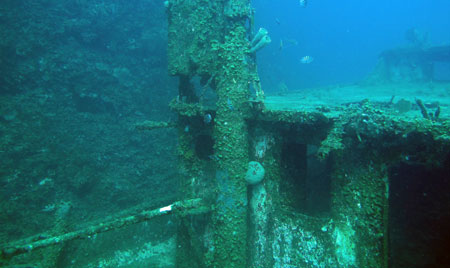
As it had on past visits, the resort put on a well-attended Buoyancy Clinic. Dive shop owner Patty Grier explained how too much weight, and improperly positioned weight, can really take the fun out of diving and making everything more difficult. The recommendation is to test proper weight by locating a shallow spot of around 15 feet towards the end of a dive, dump al the air from then BC and then see if one is neutrally buoyant. If not, one either carries too much weight, or not enough. I checked, and I carry too much. Also, the weight is apparently located too low on my body as it takes an effort for me to assume the fully horizontal swimming position. I tried to fix that by putting 8 of the 16 pounds I carried from the main weight pockets in my BC into the two small BC pockets behind me. That didn't make much of a difference in my trim and it made me feel somewhat less stable, so that is apparently not the solution.
I was also reminded how a bad dive can be a downer and a good dive a delight. We did one where we swam against a strong current for a good half hour, then turned around and somehow found ways to yet again swim against currents almost all the way back to the boat. That was no fun. On the other hand, a return to one of Roatan's star attractions, Mary's Place, was spectacular. Swimming through those very tall canyon like cracks with the light shining way above you is an experience like few others. It feels like an underwater Tolkien Middle Earth. And since the site wasn't busy and we only had a small group, we even turned around and made it through the crack from the other direction. Add to that the depth of 85 to 90 feet, and it was an incredible experience.
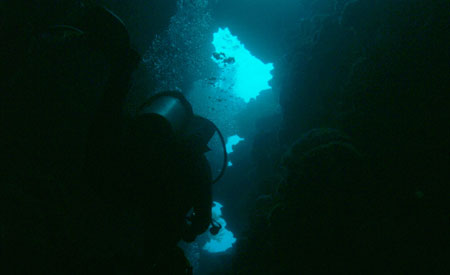
There were diving kids at CoCo View this time! They ranged in age from 12 to 14 and did amazingly well. For two of the youngsters it was their first boat dive, and they never missed a beat. Going through Mary's Place on one of your very first dives at such an early age must certainly give you a head start. I am not sure how comfortable I'd be having my son, who is 14, diving, though he's close to being certified. Yet, one of the diving kids, just 13 years old, not only had terrific air consumption, he even went on the shark dive! Not every kid will take to it equally well and progress varies from individual to individual, but by and large, these kids did great. By the end of the stay, some looked like experienced divers and had no air consumption issues either.
On this trip I had my 150th dive and my 160th, too, and then almost my 170th. Now when I meet divers who look relaxed and confident in the water, it seems like they usually have somewhere close to 200 dives, so I suppose the number of dives you need to have until you feel like you're among the advanced is a moving target. I'll never come close to having as many dives as Carol already has (almost 2,600), but that's okay. Scuba diving has truly opened new worlds for me and it has changed my life.
Lion fish are becoming a problem in Roatan as almost everywhere else in the Caribbean. They are rapidly spreading and nothing seems to stop them. In the ten years since they supposedly were accidentally released from an aquarium in Florida during a hurricane, they invaded almost the entire east coast and Caribbean. They are beautiful and exotic to look at, but are in fact fierce predators that not only propagate like rabbits, but also hunt in ways unknown to the local reef creatures and without natural enemies in the territories they invade. We had a lecture by Julia, a Ph.D. student from the University of Alabama who spent time at CoCo View doing lion fish research. It was interesting to learn more about the invasion, and some hard data and facts. Julia's main field is examining the bacterial cultures of lion fish which are very different firm those of local species. This could potentially lead to possibly detrimental infections of local species, or it might in some ways be used to fend off the invasion. Julia pointed out that lion fish invasions could have serious consequences beyond the threat to local species: since they are poisonous, beaches coiled be closed, divers may stay away, or word of mouth and bad press could negatively impact the tourist industry.
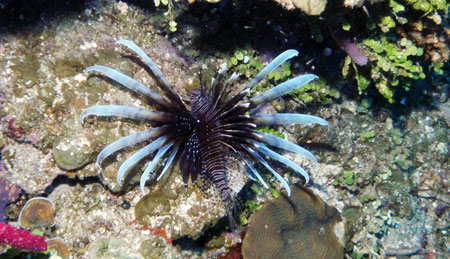
CoCo View has this system where you go out on the dive boat twice a day. The first dive on each trip is a "boat dive" and the second a "drop-off" dive. The boat dives are on different dive sites each day, and you follow the dive master. You return to the boat and stay on the boat for your surface interval. The boat then heads back towards the resort and drops you off at a location close to shore. That's usually either CoCo View Wall directly in front of the resort, or Newman's Wall across the cut where the wreck of the Prince Albert lies, in front of Fantasy Island. After being dropped off, you then work your way back to the "front yard" and then up to the shallows and the beach directly in front of the CoCo View bar and clubhouse.
Initially I didn't have much use for the drop-off dives as it was always the same dives. What I didn't consider is that wall diving is three dimensional and the same dive will be very different depending on what depth you are at. At 15-25 feet along the top of the wall, things look very different from say 45-50 feet, or at 80-100 feet where the wall meets the first of several sandy ledges and steps before dropping off vertically once again.

One afternoon, for example, we explored the top of the reef instead of the wall, and it was an almost magical experience. It was a sunny day and the afternoon sun illuminated the shallow reef for an effect that was warm and dramatic at the same time. Since it was very shallow, just between 5 and 15 feet, you could see all the colors, and that makes a huge difference. So we leisurely explored all the many chutes and channels that often make the top of a reef a fascinating maze. Due to the ever-present surge, shallow reefs close to the beach tend to be very clean and you see a lot of hard coral (as opposed to the soft, swaying life in less exposed areas). A word of warning: hard coral is hard and very sharp, and it's easy to get scraped and cut.
There is also a big difference from a boat dive where you must follow the dive master so as to get back to the boat. This means you can't linger behind when you see something interesting, and you can't move ahead when you're ready because underwater you can lose a group or a dive master very quickly even in decent visibility. You don't have that problem with a drop-off dive because you can set your own pace, and you know where to go. So each has its pros and cons.
Another thing I noticed this time is the large difference between healthy and damaged reefs. A healthy reef will have a diverse mix of strong and powerful colonies of different plants, sponges, and corals in vibrant colors. A damaged reef generally has much less color, a lot of dead and damaged plants and corals, and often a green sheen of algae in various forms, shapes, and sizes. Damaged reefs also do not look neat and clean; they often have silt and mud on them, and just generally look a bit like a garbage dump. I don't know how a reef goes from healthy and vibrant to sickly and damaged looking. Frequently, the two are close to each other. You can instantly tell which is which.
Those who remember the TV show "Fantasy Island" will see an uncanny resemblance between it and the Fantasy Island Resort across the channel from CoCo View. It's an island, it has awesome beaches including a cove, a bridge to it, a harbor, a seaplane, monkeys in the trees, hundreds of beach chairs and umbrellas, and a grand entrance. Unfortunately, everything looks sort of run down, and I hardly ever saw anyone there. Granted, this was the middle of July and thus probably not high season for the tropics, but CoCo View was pretty full. Is Fantasy Island losing it? I hope not as it wouldn't bode well for neighboring CoCo View. Fantasy Island wasn't always struggling. I was told that in the mid and late 1990s, still under the leadership of the late founder Albert Jackson, the place was packed and "a moneymaking machine." Then there came foreign investors and things went downhill. Now there's talk of new investment.
It was interesting to witness fish behavior. Little damselfish will aggressively defend their territory, leaping at divers and biting fingers and even your face when you get too close. Some speculate that lion fish stay in the walls because they don't want to risk being attacked by the damsels. Creole wrasse cruised right off the top of the walls in huge schools, with dive masters sometimes using their regulators to herd them with curtains of bubbles. Spade fish seem to cruise in gangs always seeking trouble, at times ganging up on divers and nipping at their fins, wet suits, and even regulators. They have the looks to go with their harassing behavior. Giant crabs are using their claws to pick up food stuff in front of them and then leisurely putting it into their mouths in amazingly humanlike fashion. Schools of little squids hover, occasionally burp ink, and dance in unison without apparent fear of divers. No fish will ever be touched, no matter how close they come. And it is amazing, as long as you don't harass them, how non-aggressive underwater creatures are. While mosquitoes and flies buzz you on land, dogs bark at you, and a number of animals are considered dangerous, underwater everything just goes their way. You can get within inches of a big lobster or crab, and it won't lunge at you. And when we saw 7 or 8-foot Moray Eels swimming we pursued them to get pictures rather than recoiling in fear. As long as you respect their territory and homes, you have nothing to fear from underwater life.
 The water temperature in mid July was between 84 and 86 degrees Fahrenheit. That was warm enough for many to dive in just a bathing suit. I always wore my 3-mil wetsuit. Even 84 degrees is still 14 degrees below body temperature, and so it is possible to get cold on long dives (and all of our dives were between 60 and 90 minutes). The 3-mil worked just fine for me and a full suit also offers protection from scrapes and stings (we did encounter very small jellies when coming up a couple of times, and in wrecks it's also a good idea).
The water temperature in mid July was between 84 and 86 degrees Fahrenheit. That was warm enough for many to dive in just a bathing suit. I always wore my 3-mil wetsuit. Even 84 degrees is still 14 degrees below body temperature, and so it is possible to get cold on long dives (and all of our dives were between 60 and 90 minutes). The 3-mil worked just fine for me and a full suit also offers protection from scrapes and stings (we did encounter very small jellies when coming up a couple of times, and in wrecks it's also a good idea).
Since we're always testing underwater equipment on our dive trips, we used different cameras almost every day. This time we encountered an unusual number of glitches and also made a few mistakes. One of the two battery housing covers on our video mask cracked, rendering it unusable. I somehow forgot the charger for the G-Series Canon and relied on another friendly Canon owner for charges. I also recorded a lot of precious video on the Canon without switching the camera to underwater white balance, assuming automatic would be smart enough to recognize and adapt to underwater conditions. It wasn't. Our Flip HD video recorder that we tested inside an Ikelite housing stopped recording altogether and nothing we tried could revive it. This means we've had extraordinarily bad luck with Flips underwater, and they are usually rock-solid. A dSLR began displaying nothing but blur 20 minutes into dives, though camera operation seemed unaffected, and there was no noticeable fogging anywhere. Another camera fogged the lens of its housing about half an hour into each dive, and continued doing so no matter what we tried. Sometimes it cleared up later in the dive, sometimes it didn't. We always pass these experiences on to manufacturers. Some appreciate the reports and use them to improve their products, others view them as unwanted criticism.
When you're a new diver you constantly worry about air consumption and wonder how experienced divers use so little when you use so much. After a number of dives anxiety levels go down and you learn to control your breathing, and a bottle lasts longer. On this trip, a combination of things made air last longer for me. The resort consistently provided good fills. Unlike during earlier stays where fills often barely registered 2700, this time they were always at least 2900 psi and often over 3000 and up to 3200. That makes a difference. We also generally stayed shallower and I was definitely more relaxed, now that I have a decent number of dives to my name. So the typical one hour dives no longer ended with just 400 or 500 psi left over, but generally quite a bit more. A couple of drop-off dive went a full 100 minutes. Carol's air consumption is still much better than mine, and she used a small 60 cubic foot tank the whole time, as compared to the standard 80s. That way our air lasted about the same time.
Roatan seems an odd mix between English-speaking and Spanish-speaking people. Being part of Honduras, the official language should be Spanish, but those from English towns on the island were usually brought up speaking English and many only speak broken Spanish. And they insist that English is the official language. My guess is that Spanish will win out, and that may or may not be an advantage for an island that pretty much lives on tourism.
A few words about equipment. Ever since my dive computer conked out in the middle of a live aboard dive trip, I've been wearing two, one on each wrist. That way, if one fails I still have one left, and if Carol's fails, she can use one of mine as we will have the same dive profiles. As mentioned, wearing a full 3-mil wetsuit and dive boots worked well for me. Apart from staying comfortable, a full suit also provides protection from stings, scrapes and bites, and all those can happen with bare skin. The Roatan Marine Park does not allow the wearing of gloves so as to discourage divers from handling things underwater or grabbing sensitive coral and plants, and that's fine, but there are situations where you'd like to have gloves, such as around and inside a wreck with sharp and rusty metal. I also tried a new ultra-low volume Aqua Lung technisub micromask with split lenses. It worked very well and provided a great viewing angle, almost like not wearing a mask, but it was so small its skirt left marks in my face for hours after each dive. I did not bring a snorkel and regretted that, not so much on dives, but for during surface intervals when we often just played in shallow water.
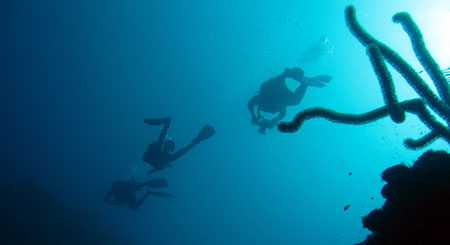
On one of the dives I came across something that cannot be. Red at 60 feet. It cannot be because the color red disappears at about 15 feet, orange at maybe 30, then yellow. It's just a fact of diving physics. Yet, there it was, bright red at just over 60 feet. I took a picture of it without flash, and the camera saw the red as well. I took another with the flash on, and on that one, the flash brought out all the colors as it usually does. So far I have not come across a good explanation of what that red was, and why I could see it.
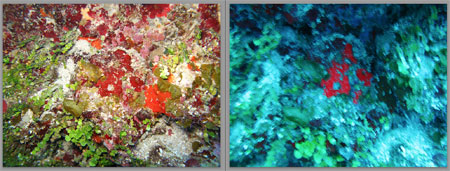
On the way back to California I again realized the folly of computerized booking systems that suggest flights with just half an hour or so to make a connection at an international airport. You need at least an hour and a half, what with the lines at immigration and customs. The frequent flier miles tickets also had us go from Roatan to Houston, then to Wichita, then to Denver, and only from there back to Sacramento. I am not sure how this could make financial sense for the airline, but then again we’re talking an industry that routinely loses billions while seemingly determine to harass its customers until they’ll simply stop flying altogether. As is, the Wichita flight was way late, and after a 45 minute palaver with airline service, we ended up on a direct flight from Houston to Sacramento. Why didn’t they do that in the first place?
Posted by conradb212 at July 29, 2010 5:11 PM








